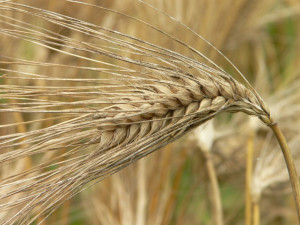Genomic regions containing two-thirds of all annotated barley genes have been sequenced.
The Science:
Researchers generated nearly 16,000 sequences of gene-containing regions for barley, mapping approximately two-thirds of all annotated barley genes.

Sequencing and assembling the barley genome is challenging not just because of its 5.1 billion base pairs size, but because over 80 percent of the sequence is repetitive. (Credit: Craig Nagy via Flickr CC BY-SA 2.0 license.)
The Impact:
While researchers continue to work on a complete reference sequence for the barley genome, the determination of improved sequence assemblies for the regions rich in barley genes allows the research community to conduct comparative genomics studies with related crops such as rice and other grasses for applications including biofuel production.
Summary
One of the reasons barley is a candidate bioenergy crop is that, as one of the most widely grown food crops, plant breeders have figured out how to produce high yields. For commercial purposes, both the straw and the grain can be utilized to produce biofuels. However, producing a reference sequence for barley has been challenging because over 80 percent of the genome (which is already 67 percent larger than the human genome) is repetitive. To help with the international effort to produce a reference barley genome, in 2011, the DOE Joint Genome Institute, a DOE Office of Science User Facility, selected a proposal to develop a genetic map of the barley genome as a Community Science Program project.
Building off of worldwide efforts, a team involving DOE JGI researchers recently reported that nearly two-thirds of barley’s gene space has been mapped. In the study published ahead online August 7, 2015 in The Plant Journal, the team identified and sequenced over 15,000 bacterial artificial chromosomes (BACs) containing barley genes, comprising roughly 1.7 billion base pairs (Gbp) of sequence out of the estimated 5.1 Gbp that makes up the barley genome.
“These ~1.7 Gb of gene-rich genomic sequence expand our knowledge of the characteristic features of the gene-containing regions,” the team reported. “Furthermore, this resource will improve the speed and precision of map-based cloning and marker development in barley and closely related species while supporting ongoing efforts in obtaining a complete reference sequence of barley.”
The researchers made use of an earlier project in which a team, also involved DOE JGI researchers, evaluated a method for assembling complex plant genomes. Using the technique called POPSEQ, researchers rapidly and inexpensively assembled barley genome datasets as proof of principle. The knowledge of these particular genes will materially help the community of scientists interested in research on barley exploit them. Importantly, having a much higher-resolution sequence-based map of the barley genome will make it easier for scientists to search out and identify genes involved in traits of interest for a variety of uses, among them generation of biomass for energy.
Contact
Jeremy Schmutz
DOE Joint Genome Institute Plant Program Head
HudsonAlpha Institute for Biotechnology
[email protected]
Funding
- U.S. Department of Energy Office of Science
- U.S. Department of Agriculture
- National Science Foundation Plant Genome Research Program
- University of California, Riverside
Publication
Muñoz-Amatriaín M et al. Sequencing of 15,622 gene-bearing BACs clarifies the gene-dense regions of the barley genome. Plant J. 2015 Aug 7. ‘Accepted Article.’ doi: 10.1111/tpj.12959.